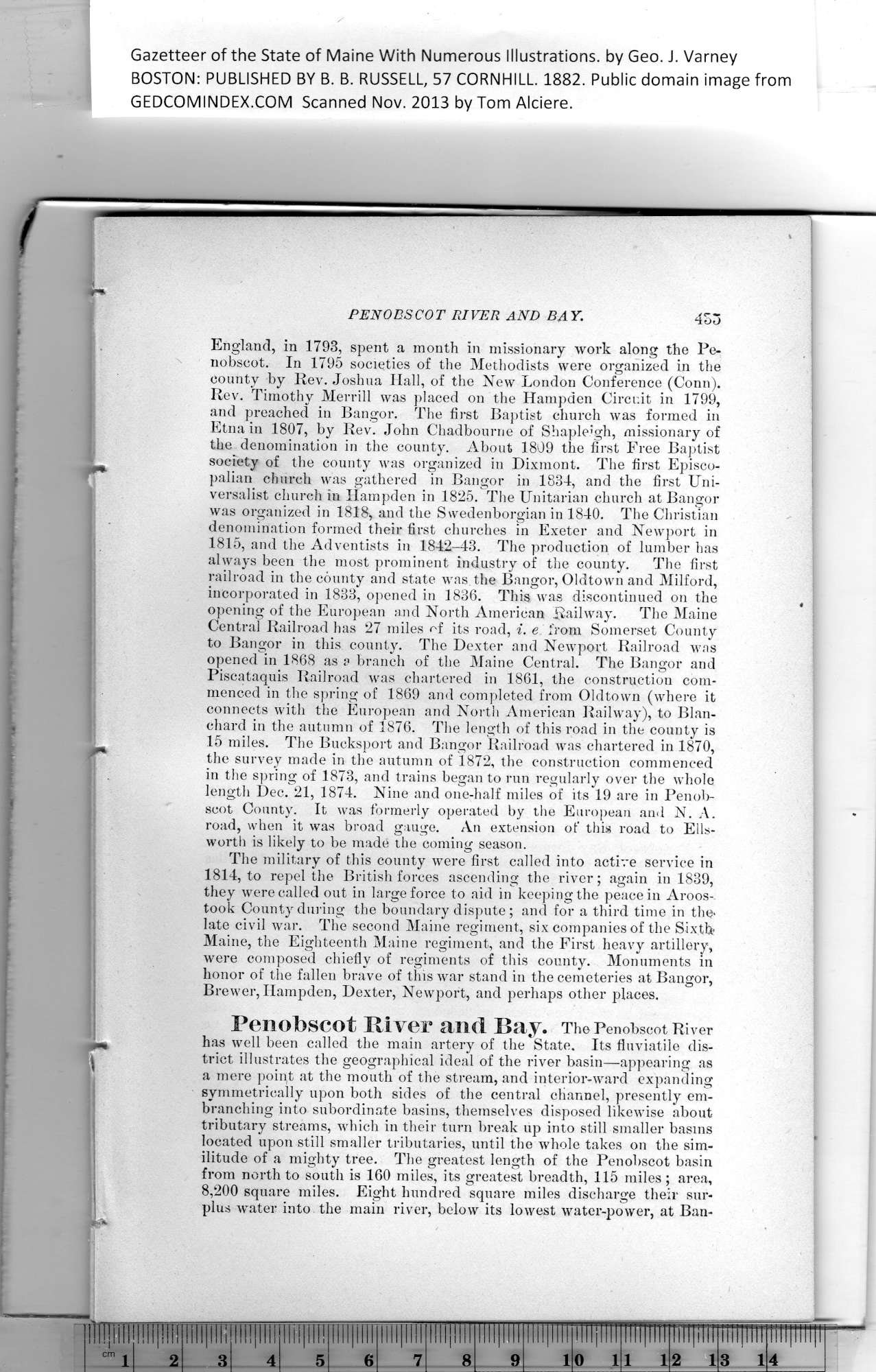|
Gazetteer of the State of Maine With Numerous Illustrations, by Geo. J. Varney
BOSTON: PUBLISHED BY B. B. RUSSELL, 57 CORNHILL. 1882. Public domain image from
PENOBSCOT RIVER AND BAY. 4Zo
England, in 1793, spent a month in missionary work along the Pe-
nobscot. In 1795 societies of the Methodists were organized in the
county by Rev. Joshua Hall, of the New London Conference (Conn).
Rev. Timothy Merrill was placed on the Hampden Circuit in 1799,
and preached in Bangor. The first Baptist church was formed in
Etna in 1807, by Rev. John Chadbourne of Shapleigh, missionary of
the denomination in the county. About 1809 the first Free Baptist
society of the county was organized in Dixmont. The first Episco-
palian church was gathered in Bangor in 1834, and the first Uni-
versalist church in Hampden in 1825. The Unitarian church at Bangor
was organized in 1818, and the Svvedenborgian in 1840. The Christian
denomination formed their first churches in Exeter and Newport in
1815, and the Adventists in 1842-43. The production of lumber has
always been the most prominent industry of the county. The first
railroad in the county and state was the Bangor, Oldtown and Milford,
incorporated in 1833, opened in 1836. This was discontinued on the
opening of the European and North American Railway. The Maine
Central Railroad has 27 miles of its road, i. e, from Somerset County
to Bangor in this county. The Dexter and Newport Railroad was
opened in 1868 as a branch of the Maine Central. The Bangor and
Piscataquis Railroad was chartered in 1861, the construction com-
menced in the spring of 1869 and completed from Oldtown (where it
connects with the European and North American Railway), to Blan-
chard in the autumn of 1876. The length of this road in the county is
15 miles. The Bucksport and Bangor Railroad was chartered in 1870,
the survey made in the autumn of 1872, the construction commenced
in the spring of 1873, and trains began to run regularly over the whole
length Dec. 21, 1874. Nine and one-half miles of its 19 are in Penob-
scot County. It was formerly operated by the European and N. A.
road, when it was broad gauge. An extension of this road to Ells-
worth is likely to be made the coming season.
The military of this county were first called into active service in
1814, to repel the British forces ascending the river; again in 1839,
they were called out in large force to aid in keeping the peace in Aroos-.
took County during the boundary dispute; and for a third time in the*
late civil war. The second Maine regiment, six companies of the Sixth*
Maine, the Eighteenth Maine regiment, and the First heavy artillery,
were composed chiefly of regiments of this county. Monuments in
honor of the fallen brave of this war stand in the cemeteries at Bangor,
Brewer, Hampden, Dexter, Newport, and perhaps other places.
Penobscot River and Bay. The Penobscot River
has well been called the main artery of the State, Its fluviatile dis-
trict illustrates the geographical ideal of the river basin—appearing as
a mere point at the mouth of the stream, and interior-ward expanding
symmetrically upon both sides of the central channel, presently em-
branching into subordinate basins, themselves disposed likewise about
tributary streams, which in their turn break up into still smaller basins
located upon still smaller tributaries, until the whole takes on the sim-
ilitude of a mighty tree. The greatest length of the Penobscot basin
from north to south is 160 miles, its greatest breadth, 115 miles; area,
8,200 square miles. Eight hundred square miles discharge their sur-
plus water into the main river, below its lowest water-power, at Ban-
PREVIOUS PAGE ... NEXT PAGE
This page was written in HTML using a program written in Python 3.2
|
